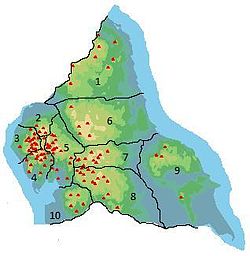Cringle Moor
Cringle Moor (also known as Cranimoor), at 432 m (1,417 ft), is the third-highest hill in the North York Moors, England, and the highest point west of Clay Bank.
The hill is crossed by the Cleveland Way National Trail and is a part of Alfred Wainwright's Coast to Coast Walk, which also passes over the neighbouring tops of Cold Moor, Carlton Moor, Live Moor and Hasty Bank — a section of the walk which Wainwright described as "one of the finest". It is also part of the Lyke Wake Walk.
Just to the west of the summit is the burial mound of 'Drake Howe (Howe is an Old Norse word meaning "burial mound"). This Bronze Age burial mound is now a scheduled ancient monument.
Gallery
-
Cringle Moor from Bank Lane
-
Cringle Moor from Cold Moor
-
Cringle Moor's northern face
-
Stone seat on Cringle Moor
-
View north from Cringle Moor
References
- ^ Elgee, Frank (1912). The Moorlands of North-Eastern Yorkshire: their natural history and origin. London: A Brown & Sons. p. 234. OCLC 776748510.
- ^ "OL26" (Map). North York Moors - Western area. 1:25,000. Explorer. Ordnance Survey. 2016. ISBN 9780319242650.
- ^ Dillon, Paddy (2005). The North York Moors (2 ed.). Milnthorpe: Cicerone. p. 87. ISBN 978-1-85284-448-6.
- ^ Wills, Dixe (30 August 2012). "Boots, anorak, coffin … the Yorkshire walk with a difference". The Guardian. Retrieved 28 November 2017.
- ^ Reid, Mark. "Cringle Moor from Lord Stones' Cafe - Dalesman". dalesman.co.uk. Retrieved 28 November 2017.
- ^ Historic England. "Round barrow at Drake Howe (1010531)". National Heritage List for England. Retrieved 28 November 2017.
External links
Wikimedia Commons has media related to Cringle Moor.






